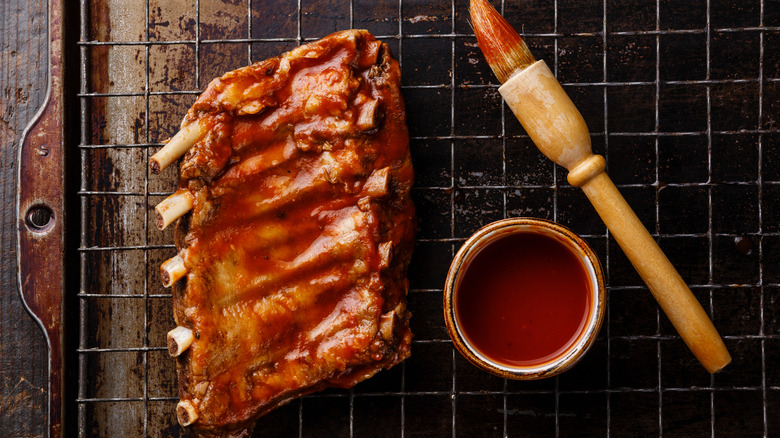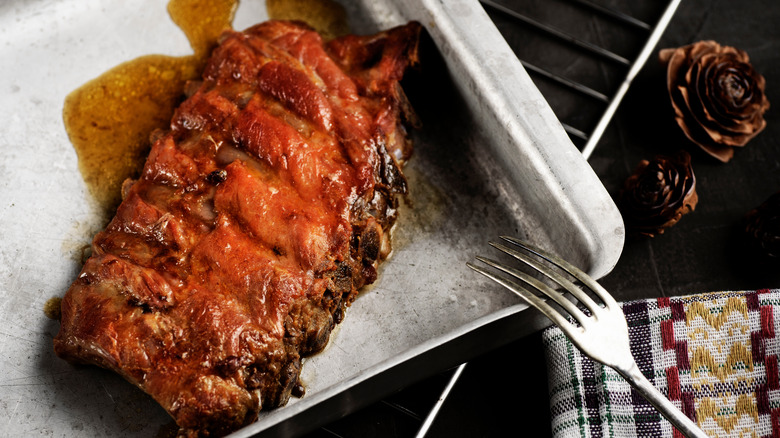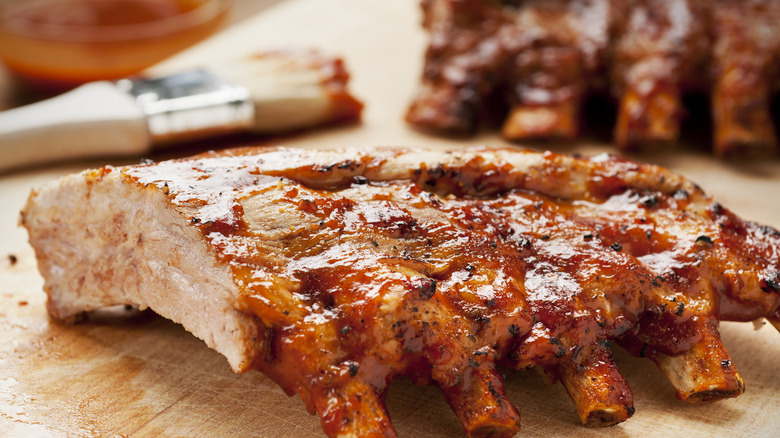A Second Sauce Layer Is Key To Perfectly Reheated Ribs
Ribs are unbeatable when served fresh from the grill or barbecue, especially when they're smothered with a rich, smoky sauce — like a homemade Tennessee whiskey barbecue sauce. That combination of beautifully charred, caramelized exterior and fall-off-the-bone tender meat is always a winner. If you've got leftovers, then you can still serve the ribs hot and juicy. It's just a case of reheating them.
But therein lies the rub — if you'll excuse the pun. Because reheating ribs — whether they're baby back ribs or St. Louis style spare ribs — can lead to them being dry, tough, and disappointing, especially when compared to freshly cooked. Luckily, there are a few things you can do while reheating leftover ribs to help return them to their original glory, or at least something close to it. The stages involve time, temperature, and barbecue sauce.
While there are many methods to reheat ribs, from the microwave to the air fryer, covering the ribs and reheating them slowly in a low oven is one of the best ways to avoid overcooking them. And if you want tender, moist, and flavorful meat, then adding an additional layer of barbecue sauce during the reheating process will enhance both the taste and texture of the ribs — bringing moisture and added flavor. It's a simple extra step, but one well worth doing to produce the tastiest, juiciest meat for a finger-licking treat.
Add sauce during reheating for caramelized ribs
One of the problems when reheating leftover ribs is that they can go hard and dry when stored in the fridge, and then become even more tough when reheated. The fluctuations in temperature don't help. So the first step to reheating ribs is to take them out of the refrigerator in advance. Letting them warm up for around 30 minutes before they hit the oven may improve the texture. Then cover the ribs in foil and reheat them at around 220 degrees Fahrenheit for around 30 minutes in a low oven, or until they reach the USDA-recommended internal temperature of 165 degrees Fahrenheit.
While there are several different styles of American barbecue, many share similarities in terms of the process, and that includes the right time to apply barbecue sauce to avoid it either burning or just sitting on top of the meat without penetrating it. That ideal time is around 15 minutes before the meat is done to get perfectly caramelized meat with a crispy crust.
When reheating leftover ribs in the oven, a similar strategy applies. The best time to apply the second layer of barbecue sauce is towards the end of reheating; again, about 10 to 15 minutes before the end of the time in the low oven is ideal. Uncovering the ribs once they're coated in the additional layer of barbecue sauce means the sugars can begin to caramelize in the heat of the oven.
Other ways to reheat ribs, and why low and slow is best
The reason barbecued ribs are so delicious is the time that is put into them. They're cooked low and slow, with spices and seasonings in the barbecue sauce adding flavor as well as a caramelized texture and glossy finish. When reheating them, you want to replicate that process as far as possible so that the leftover ribs are just as tender and flavorful as when they were first cooked, which is why the low oven method works well.
Another effective method is the grill, which delivers extra smoky flavor. Preheat the grill to high, and add extra barbecue sauce to the room-temperature ribs before loosely wrapping them in foil. Turn the heat to medium, and give them around 10 minutes for tender ribs with that straight-off-the-barbecue taste.
Other low and slow methods include reheating ribs sous vide in a vacuum-sealed bag. Or try using a steamer, heating the ribs for around 30 minutes above a large pot of liquid (water, broth, or beer) for moist, juicy meat. The microwave isn't ideal as it can dry out the ribs; and while the air fryer can work well, it's more suited to reheating dry ribs with a rub rather than wetter, saucy ones. When reheating leftover ribs, just as when cooking them in the first place, take your time for the best results. As with most things barbecue, patience and process are always rewarded.



